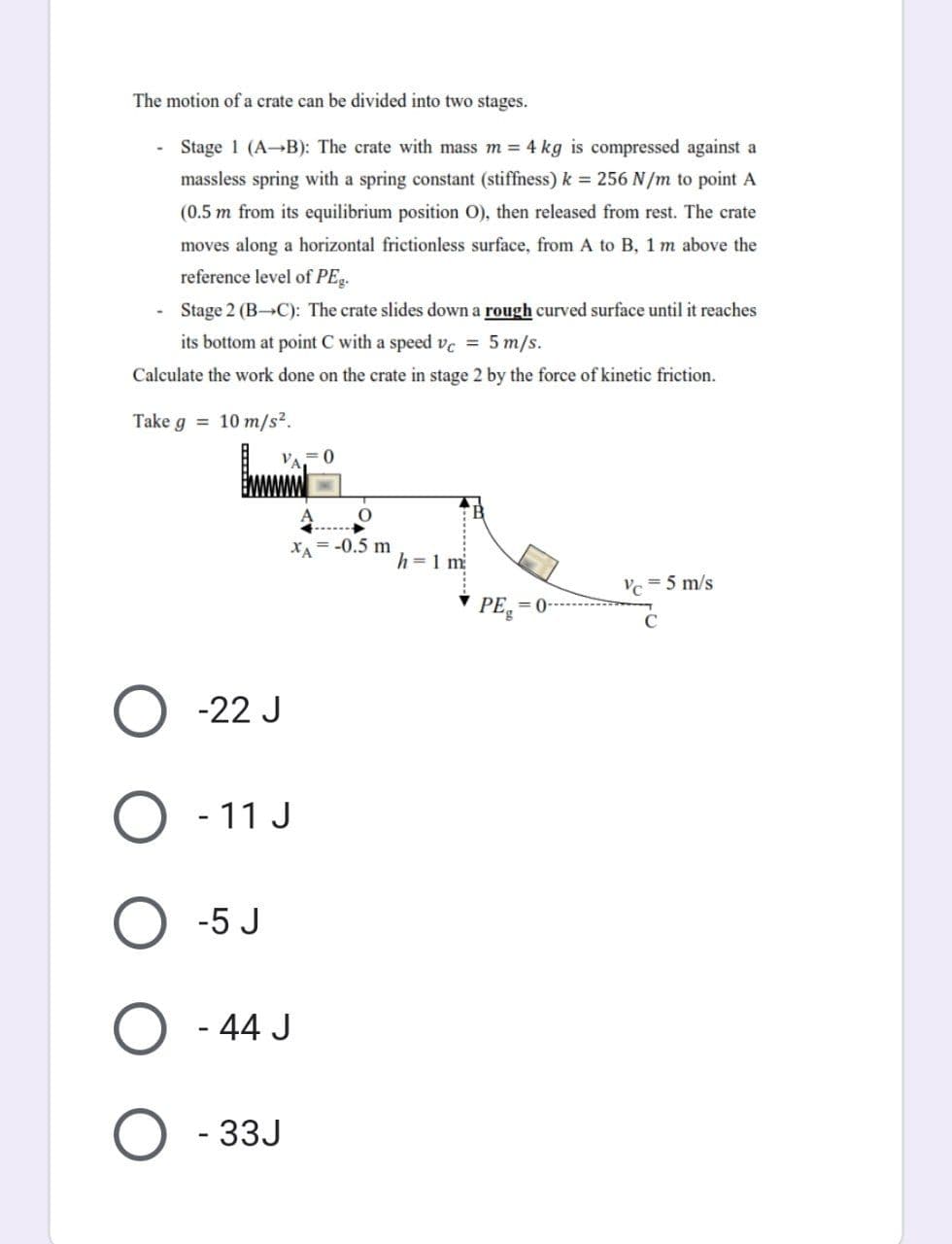The motion of a crate can be divided into two stages. Stage 1 (A-B): The crate with mass m = 4 kg is compressed against a massless spring with a spring constant (stiffness) k = 256 N/m to point A (0.5 m from its equilibrium position O), then released from rest. The crate moves along a horizontal frictionless surface, from A to B, 1 m above the reference level of PEg. Stage 2 (B-C): The crate slides down a rough curved surface until it reaches its bottom at point C with a speed vc = 5 m/s. Calculate the work done on the crate in stage 2 by the force of kinetic friction. Take g = 10 m/s². VA 0 XA h = 1 m = 5 m/s O -22 J O - 11 J -5 J O - 44 J - 33J O -0.5 m PE = 0- Vc
The motion of a crate can be divided into two stages. Stage 1 (A-B): The crate with mass m = 4 kg is compressed against a massless spring with a spring constant (stiffness) k = 256 N/m to point A (0.5 m from its equilibrium position O), then released from rest. The crate moves along a horizontal frictionless surface, from A to B, 1 m above the reference level of PEg. Stage 2 (B-C): The crate slides down a rough curved surface until it reaches its bottom at point C with a speed vc = 5 m/s. Calculate the work done on the crate in stage 2 by the force of kinetic friction. Take g = 10 m/s². VA 0 XA h = 1 m = 5 m/s O -22 J O - 11 J -5 J O - 44 J - 33J O -0.5 m PE = 0- Vc
Principles of Physics: A Calculus-Based Text
5th Edition
ISBN:9781133104261
Author:Raymond A. Serway, John W. Jewett
Publisher:Raymond A. Serway, John W. Jewett
Chapter4: The Laws Of Motion
Section: Chapter Questions
Problem 54P: A student is asked to measure the acceleration of a glider on a frictionless, inclined plane, using...
Related questions
Question

Transcribed Image Text:The motion of a crate can be divided into two stages.
Stage 1 (A-B): The crate with mass m = 4 kg is compressed against a
massless spring with a spring constant (stiffness) k = 256 N/m to point A
(0.5 m from its equilibrium position O), then released from rest. The crate
moves along a horizontal frictionless surface, from A to B, 1 m above the
reference level of PEg.
Stage 2 (B-C): The crate slides down a rough curved surface until it reaches
its bottom at point C with a speed vc = 5 m/s.
Calculate the work done on the crate in stage 2 by the force of kinetic friction.
Take g = 10 m/s².
VA
0
= -0.5 m
h = 1 m
Vc = 5 m/s
ХА
-22 J
O - 11 J
O -5 J
O - 44 J
O-33J
PE
= 0-
Expert Solution
This question has been solved!
Explore an expertly crafted, step-by-step solution for a thorough understanding of key concepts.
Step by step
Solved in 3 steps with 3 images

Knowledge Booster
Learn more about
Need a deep-dive on the concept behind this application? Look no further. Learn more about this topic, physics and related others by exploring similar questions and additional content below.Recommended textbooks for you

Principles of Physics: A Calculus-Based Text
Physics
ISBN:
9781133104261
Author:
Raymond A. Serway, John W. Jewett
Publisher:
Cengage Learning

Classical Dynamics of Particles and Systems
Physics
ISBN:
9780534408961
Author:
Stephen T. Thornton, Jerry B. Marion
Publisher:
Cengage Learning

Principles of Physics: A Calculus-Based Text
Physics
ISBN:
9781133104261
Author:
Raymond A. Serway, John W. Jewett
Publisher:
Cengage Learning

Classical Dynamics of Particles and Systems
Physics
ISBN:
9780534408961
Author:
Stephen T. Thornton, Jerry B. Marion
Publisher:
Cengage Learning